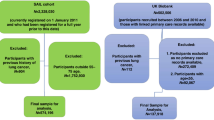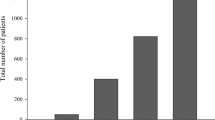Abstract
A high proportion of lung cancer cases are detected at a late cancer stage when they present with symptoms to general practitioners (GP). Early diagnosis is a challenge because many symptoms are also common in other diseases. Therefore, this study aims to assess UK primary care data of patients one, two and three years prior to lung cancer diagnosis to capture trends in clinical features of patients with the goal of early diagnosis and thus potentially curative treatment. This longitudinal study utilises data from the Clinical Practice Research Datalink (CPRD) with linked data from the National Cancer Registration and Analysis Service (NCRAS). A comprehensive list of Read codes is created to select features of interest to establish if a patient has experienced a certain medical condition or not. The comparison of the relative frequencies of the identified predictors associated with cases and controls reveals the importance of the following groups of features: ‘Cough Wheeze’ and ‘Bronchitis unspecified’, ‘Dyspnoea’ and ‘Upper Respiratory Infection’, which are frequent events for lung cancer cases, where a high proportion of cases were also identified using ‘Haemoptysis’ and ‘Peripheral vascular disease’.
Access this chapter
Tax calculation will be finalised at checkout
Purchases are for personal use only
Similar content being viewed by others
References
Becker, N., et al.: Randomized study on early detection of lung cancer with MSCT in Germany: results of the first 3 years of follow-up after randomization. J. Thorac. Oncol. 10(6), 890–896 (2015)
Chen, L., Yan, J., Chen, J., Sheng, Y., Xu, Z., Mahmud, M.: An event based topic learning pipeline for neuroimaging literature mining. Brain Inf. 7(1), 1–14 (2020). https://doi.org/10.1186/s40708-020-00121-1
Ferlay, J., et al.: Cancer incidence and mortality patterns in Europe: estimates for 40 countries in 2012. Eur. J. Cancer 49(6), 1374–1403 (2013)
Field, J.K., et al.: The UK lung cancer screening trial: a pilot randomised controlled trial of low-dose computed tomography screening for the early detection of lung cancer. Health Technol. Assess. (Winchester, England) 20(40), 1 (2016)
Herrett, E., et al.: Data resource profile: clinical practice research datalink (CPRD). Int. J. Epidemiol. 44(3), 827–836 (2015)
Infante, M., et al.: Long-term follow-up results of the DANTE trial, a randomized study of lung cancer screening with spiral computed tomography. Am. J. Respir. Crit. Care Med. 191(10), 1166–1175 (2015)
Kaiser, M.S., et al.: iWorksafe: towards healthy workplaces during COVID-19 with an intelligent phealth app for industrial settings. IEEE Access 9, 13814–13828 (2021)
van Klaveren, R.J., et al.: Management of lung nodules detected by volume CT scanning. New England J. Med. 361(23), 2221–2229 (2009)
López, V., Fernández, A., García, S., Palade, V., Herrera, F.: An insight into classification with imbalanced data: empirical results and current trends on using data intrinsic characteristics. Inf. Sci. 250, 113–141 (2013)
Mahmud, M., Kaiser, M.S.: Machine learning in fighting pandemics: a COVID-19 case study. In: Santosh, K.C., Joshi, A. (eds.) COVID-19: Prediction, Decision-Making, and its Impacts. LNDECT, vol. 60, pp. 77–81. Springer, Singapore (2021). https://doi.org/10.1007/978-981-15-9682-7_9
Mahmud, M., Kaiser, M.S., McGinnity, T.M., Hussain, A.: Deep learning in mining biological data. Cogn. Comput. 13(1), 1–33 (2020). https://doi.org/10.1007/s12559-020-09773-x
Mahmud, M., Kaiser, M.S., Hussain, A., Vassanelli, S.: Applications of deep learning and reinforcement learning to biological data. IEEE Trans. Neural Netw. Learn. Syst. 29(6), 2063–2079 (2018)
Mathers, C.D., Loncar, D.: Projections of global mortality and burden of disease from 2002 to 2030. PLoS Med. 3(11), 1 (2006)
McDonald, L., et al.: Suspected cancer symptoms and blood test results in primary care before a diagnosis of lung cancer: a case-control study. Future Oncol. 15(33), 3755–3762 (2019)
Nahian, M.J.A., et al.: Towards an accelerometer-based elderly fall detection system using cross-disciplinary time series features. IEEE Access 9, 39413–39431 (2021)
Noor, M.B.T., et al.: Application of deep learning in detecting neurological disorders from magnetic resonance images: a survey on the detection of Alzheimer’s disease, Parkinson’s disease and schizophrenia. Brain Inf. 7(1), 1–21 (2020)
Paci, E., et al.: Mortality, survival and incidence rates in the ITALUNG randomised lung cancer screening trial. Thorax 72(9), 825–831 (2017)
Padmanabhan, S.: Cprd gold data specification (2015). https://www.ed.ac.uk/files/atoms/files/cprd_gold_full_data_specification. pdf
Sverzellati, N., et al.: Low-dose computed tomography for lung cancer screening: comparison of performance between annual and biennial screen. Eur. Radiol. 26(11), 3821–3829 (2016). https://doi.org/10.1007/s00330-016-4228-3
Team, N.L.S.T.R.: Reduced lung-cancer mortality with low-dose computed tomographic screening. New Engl. J. Med. 365(5), 395–409 (2011)
Wille, M.M., et al.: Results of the randomized Danish lung cancer screening trial with focus on high-risk profiling. Am. J. Respir. Crit. Care Med. 193(5), 542–551 (2016)
Acknowledgement
We would like to thank the Medical Technologies and Advanced Materials Strategic Research Theme at Nottingham Trent University for financial support.
Author information
Authors and Affiliations
Corresponding author
Editor information
Editors and Affiliations
Rights and permissions
Copyright information
© 2021 Springer Nature Switzerland AG
About this paper
Cite this paper
Alzubaidi, A. et al. (2021). Selecting Lung Cancer Patients from UK Primary Care Data: A Longitudinal Study of Feature Trends. In: Mahmud, M., Kaiser, M.S., Kasabov, N., Iftekharuddin, K., Zhong, N. (eds) Applied Intelligence and Informatics. AII 2021. Communications in Computer and Information Science, vol 1435. Springer, Cham. https://doi.org/10.1007/978-3-030-82269-9_4
Download citation
DOI: https://doi.org/10.1007/978-3-030-82269-9_4
Published:
Publisher Name: Springer, Cham
Print ISBN: 978-3-030-82268-2
Online ISBN: 978-3-030-82269-9
eBook Packages: Computer ScienceComputer Science (R0)




